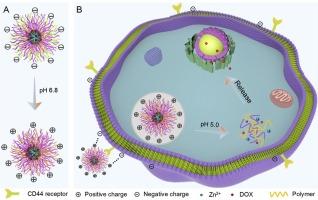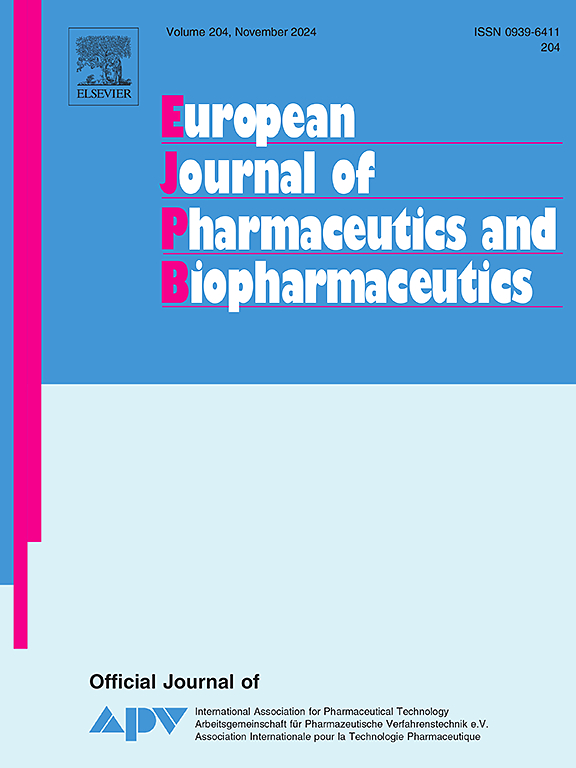Charge reversible hyaluronic acid-based drug delivery system with pH-responsive dissociation for enhanced drug delivery
IF 4.4
2区 医学
Q1 PHARMACOLOGY & PHARMACY
European Journal of Pharmaceutics and Biopharmaceutics
Pub Date : 2024-10-22
DOI:10.1016/j.ejpb.2024.114560
引用次数: 0
Abstract
Improving the efficiency of drug delivery is one of the most important goals in the field of drug delivery. One strategy for drug delivery efficiency is to make the drug delivery system capable of charge reversal. In this study, we used hyaluronic acid (HA) as the skeleton to anchor dimethylmaleic anhydride-modified polylysine (PLL-DMMA) and N-(3-Aminopropyl)-imidazole (IMI) to construct a pH-sensitive (IMI/Zn2+)-HA-PLL-DMMA system via Zn coordination. The (IMI/Zn2+)-HA-PLL-DMMA system can detach DMMA moieties and expose PLL with a positive charge in the acidic tumor microenvironment (TME), which enhances cellular uptake in cancer cells through charge reversal. Once the drug-loaded (IMI/Zn2+)-HA-PLL-DMMA enters cancer cells, it specifically responds and disassembles in the acidic TME, resulting in drug release and inhibition of cancer cell viability. The (IMI/Zn2+)-HA-PLL-DMMA system is designed to regulate drug release behavior with Zn2+ and IMI groups as control units. The HA-based system shows synergistic selective drug delivery in suppressing tumor cells and has potential in cancer therapy.

基于透明质酸的电荷可逆给药系统,具有 pH 值响应解离功能,可增强给药效果。
提高给药效率是给药领域最重要的目标之一。提高给药效率的策略之一是使给药系统具有电荷反转能力。在这项研究中,我们以透明质酸(HA)为骨架,锚定二甲基马来酸酐修饰的聚赖氨酸(PLL-DMMA)和 N-(3-氨基丙基)咪唑(IMI),通过 Zn 配位构建了 pH 敏感的(IMI/Zn2+)-HA-PLL-DMMA 系统。(IMI/Zn2+)-HA-PLL-DMMA体系能在酸性肿瘤微环境(TME)中脱离DMMA分子并暴露出带正电荷的PLL,从而通过电荷反转增强癌细胞的吸收。载药(IMI/Zn2+)-HA-PLL-DMMA 进入癌细胞后,会在酸性肿瘤微环境中发生特异性反应并分解,从而释放药物并抑制癌细胞的活力。IMI/Zn2+)-HA-PLL-DMMA 系统的设计目的是以 Zn2+ 和 IMI 组作为控制单元来调节药物释放行为。基于 HA 的系统在抑制肿瘤细胞方面显示出协同选择性给药作用,在癌症治疗方面具有潜力。
本文章由计算机程序翻译,如有差异,请以英文原文为准。
求助全文
约1分钟内获得全文
求助全文
来源期刊
CiteScore
8.80
自引率
4.10%
发文量
211
审稿时长
36 days
期刊介绍:
The European Journal of Pharmaceutics and Biopharmaceutics provides a medium for the publication of novel, innovative and hypothesis-driven research from the areas of Pharmaceutics and Biopharmaceutics.
Topics covered include for example:
Design and development of drug delivery systems for pharmaceuticals and biopharmaceuticals (small molecules, proteins, nucleic acids)
Aspects of manufacturing process design
Biomedical aspects of drug product design
Strategies and formulations for controlled drug transport across biological barriers
Physicochemical aspects of drug product development
Novel excipients for drug product design
Drug delivery and controlled release systems for systemic and local applications
Nanomaterials for therapeutic and diagnostic purposes
Advanced therapy medicinal products
Medical devices supporting a distinct pharmacological effect.

 求助内容:
求助内容: 应助结果提醒方式:
应助结果提醒方式:


